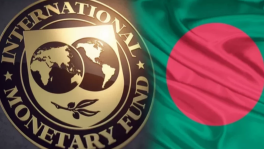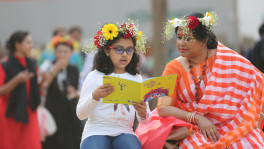Immigrants or refugees: Who really are the Maldoiyas?
It was 1971, the turbulent times of the Liberation War. Immigrants and refugees from Bangladesh were flooding West Bengal, leaving their lands and properties behind. But many of the Hindu families who were somewhat well-off and well-connected exchanged properties with Muslims in West Bengal.
After exchanging 200 bighas of land with such a Hindu family, Sagar Mohammad moved from India's Malda to Dinajpur's Mahadevpur. His three brothers followed his lead and settled in Dinajpur's Maljhar, Kanaibari and Ishanpur.
Mahadevpur is now home to 500 families – all migrated from Malda. The locals call the community Maldoiya as they came from Malda. The Maldoiyas were believed to be very good agriculturalists who would clear the uncultivated lands, cultivate them and sell the crops subsequently before moving on to another place. They became prosperous shortly after the partition of India in 1947.
There are allegations that the Maldoiyas collaborated with the Pakistan army in carrying out genocide against the Bangalees during 1971. Although they now live in groups in different parts of the country, they are still considered outsiders by locals.
It is not just that the Maldoiyas came to Bangladesh after being displaced by the 1947 partition or subsequent communal reasons. The history of their immigration is even older.
The partition of British India first prompted a process of mass migration in 1947. New border frontiers demarcated by Cyril Radcliffe cut across paddy fields, bamboo groves, sal forests, and a vast water body. Refugees crowded on both sides of the barbed wire. Then came the Hindu-Muslim riots in 1950 and 1964 in erstwhile East Pakistan, leading to an escalation of communal tensions in India too.
Thousands of Muslim families from West Bengal, especially from South Dinajpur, Malda, Murshidabad, Birbhum and Kolkata, migrated to the border areas. The influx continued throughout the twentieth century.
The roaming farmers
Since time immemorial, the Ganges Delta region has been prone to river erosion and flooding. Diara, a swathe in the southern and southwestern part of India's Malda, is a land resting on silt. People of this region make a living by farming. But river erosion would not allow them to establish permanent settlements. They had to move to new places frequently as the land would go under water every year. Diara farmers, with their itinerant way of life, were known as Diaria or Bhatia.

Owing to frequent travelling, the Maldoiyas constructed their houses with bamboo. The structures could be dismantled and erected elsewhere quickly. Unlike Bangalee Sunnis, the people would not preserve the graves of their families or build religious structures around them.
A research study, "The Bengal Diaspora: Rethinking Muslim Migration", narrates the story of such a Maldoiya family, who migrated to Murshidabad after losing land in India's Chapai area. The family finally settled in Dinajpur after brief stays at Gangarampur and then Kaliganj.
Gainers in resettlement project
After the 1947 partition, both Bangalee and non-Bangalee refugees and migrants started coming to East Pakistan. These Indian Muslim immigrants were known as Muhajirs. In the refugee resettlement scheme, the then East Pakistan aimed to turn the Muhajirs into modern citizens. Urdu-speaking immigrants like Biharis got the maximum benefit of resettlement due to their identification with the language of the Pakistani ruling class.
Educated migrants welcomed the government initiative. The scheme helped the Maldoiyas, who had cash or gold ornaments, to start new businesses. Besides, many of the immigrants got land and money from the government to establish small factories.
Immigrants who were marginalised farmers or day labourers took shelter in the bordering villages and towns after failing to access the government scheme. There is not much information or documents about these poor immigrants.
"The overall situation is serious with the arrival of thousands of refugees," the Pakistan Observer newspaper wrote in the aftermath of the 1950 riots.

Though the East Pakistan government initiated the resettlement, locals had been opposing the rehabilitation from the very beginning. Religious identity alone was not strong enough to build unity among the locals and the immigrants.
Pak spies?
There are allegations that many Maldoiyas worked as spies and informers for the Pakistan army during Bangladesh's Liberation War in 1971. There are allegations of genocide committed by the Maldoiyas in Thakurgaon. Many of them are officially listed as Razakars.
Some Maldoiyas reportedly came to Bangladesh in 1971 simply to grab properties left behind by Hindus who took shelter in India during the Liberation War. According to the research study, the Maldoiya immigrants could do so due to their ability to move around swiftly.
The study also highlights some tragedies suffered by the community in 1971. One of those happened to Bibi Hawa, who was in Chapainawabganj during the Liberation War.
After labelling them Razakars, gunmen killed Hawa's husband, three brothers-in-law and her father-in-law. The men were dragged out of their home, and shot dead one by one right in front of the woman. The armed men also looted the cattle belonging to the family.
Bibi Hawa pointed the finger at the community's gypsy-like life for its being tagged with Pakistan. She said the premeditated attack took place because locals were envious of their lands and properties. Apart from the killing in Hawa's house, the armed group killed 139 more locals.
Hopes for unity taking shape
The suspicion has remained that the Maldoiyas still oppose Bangladesh's independence and patronise the Jamaat-e-Islami. On the day of national elections in 2014, Hindu houses were attacked, looted and set on fire in Dinajpur Sadar. Most of the accused in the three cases filed at that time are from the Maldoiya community. The cases are ongoing.

In Thakurgaon, locals opposed the rehabilitation of the community after the liberation war. But the government eventually implemented the project.
How are the Maldoiyas now? Saifuddin, grandson of Sagar Mohammad who lives in Mahadevpur, said, "We are all Bangladeshis by birth, citizens of Bangladesh and voters. But even then, we are still called Maldoiyas."
Another villager there, Shukka Mohammad, said, "Many people try to say that we are supporters of BNP-Jamaat. But how can we support the BNP-Jamaat alliance when our forefathers came from India?"
Many in the Hindu community, despite bearing the brunt of communal attacks in 2014, are of the view that the past is in the past.
"We live here like brothers and don't want to have any more quarrels. We are now living in perfect communal harmony," said Harendra Roy of Dinajpur.
 Keep updated, follow The Business Standard's Google news channel
Keep updated, follow The Business Standard's Google news channel















